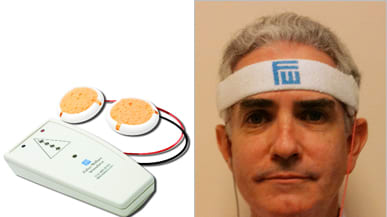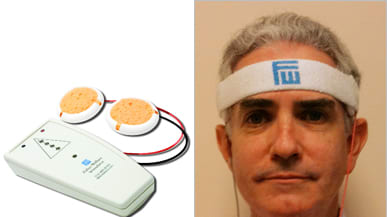All I want for Christmas is some new AT (And I want to share this other article too)
Thursday, December 14, 2017

By Aimee Sterk, LMSW, MATP Team Member
This year for Christmas, I am asking for the Fisher Wallace Stimulator device. I heard about it from my therapist. According the website, it uses electrical impulses to stimulate the brain to produce more serotonin and melatonin while reducing cortisol. It can be used for depression, anxiety, and insomnia. Fisher Wallace notes that the device is FDA cleared and has been used in many research studies.

The Fisher Wallace Stimulator and a man using the device with the moistened sponge electrodes applied to his temples and held in place by a headband. Image from the Daily Beast: https://www.thedailybeast.com/fisher-wallace-stimulator-behind-the-do-it-yourself-shock-therapy
All of this sounds so good to me right now. I was on an SSRI while pregnant with my son and it really helped me combat depression and anxiety associated with pregnancy, losses, and PTSD while I was carrying him. I took half the lowest dose of the medication prescribed. Still, just as I am highly sensitive to meds, it seems my son is too, and he had withdrawal symptoms from my medication after he was born. This was devastating to me at a time that we were already in crisis as my son had to be in the NICU after delivery for another condition.
This pregnancy, I’m determined not to take an SSRI, but am again experiencing significant anxiety and depression. I had looked into non-pharmaceutical options when pregnant with my son (specifically TMS) but the cost was very high, sometimes I met the clinical criteria and sometimes I didn’t, and the commitment of daily, somewhat painful treatment, for 4-6 weeks, at a facility across town seemed overwhelming.
So, this year, I want to try the Fisher Wallace Stimulator as a non-invasive and less costly option than TMS (it still is expensive at $699). I do wonder if I can commit to using the Fisher Wallace twice a day for 20 minutes though–with a 1-year old and another baby on the way along with a full-time job, life is pretty busy right now.
I put the word out there to coworkers, friends and family to see if anyone I know has used the device. It turns out the husband of a friend is currently using it to treat his ADHD and has seen improvements as he tries to get off of his medication.
I also did some googling. In addition to the company’s website, if you are interested, you may want to check out the guest blog on Scientific American that details another user’s story and has links to some relative research. You may also want to check out the reviews on Drugs.com which tend toward neutral or negative with some people wondering about a placebo effect.
Currently, the device is out of reach financially for me, but possibly, when my Flexible Spending Account balance refills January 1st, I’ll get a prescription and consider giving this device a try (unless Santa delivers one first). In the meantime, I’m tracking my mood, taking my vitamin D, practicing mindful self-compassion and the lovingkindness meditation.
Have you tried the device? Did it make a difference in your life? What AT or techniques have you used for depression and anxiety when medication wasn’t an option?
And speaking of mental health, I have to share this amazingly good article that I learned about from Disability Network Southwest Michigan staff. It deeply speaks to me and has also touched colleagues and friends—a must read for people with mental illness and allies. It covers the dangers of being “High Functioning” (the authors words, ones I don’t use myself) mentally ill and touches on the damage of disability hierarchies and the intersectionality of mental health/disability and other identities. Why I’m Done Being a Good Mentally Ill Person.

